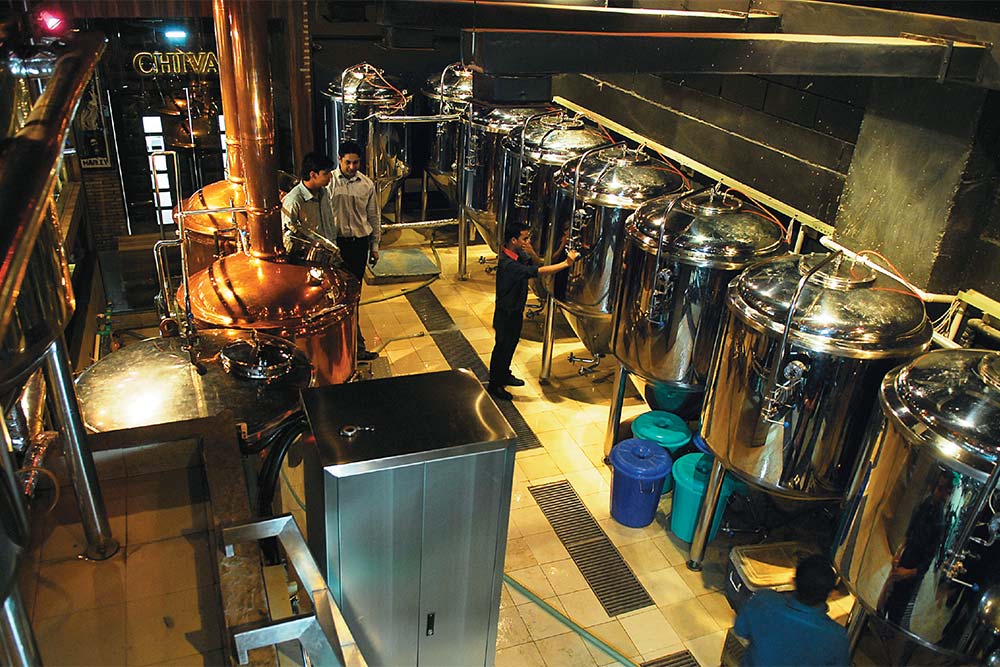Beer is no longer the stuff you pour out of a bottle. In Gurgaon, now, three large drums make a microbrewery. Microbrewing, the business of crafting beer in the house, is the cool new fad in the National Capital Region, Bengaluru, Pune and Chandigarh.
“It was a bit of a risk in the early days, since people were used to bottled beer — they weren’t even comfortable with being served in a mug,” says Hemant Nautiyal, general manager of the microbrewery Striker. “Gurgaon has a sizeable population of those who are well-travelled or have lived abroad, and they were the early customers.” And so, the first microbrewery came up in Gurgaon, in 2008. The Haryana government issues an L10C licence that lets pubs brew and sell beer in its premises. But it cannot be bottled and sold outside.
Surely, the trend is growing as more licences are being given. In Gurgaon, the places with the right ambience are proving to be the winners. Howzzat is a sports-themed pub where people cheer their team as they drink the house brew. Rockman’s Island has its own Oktoberfest and Striker is the music enthusiasts’ haunt.
Surprisingly, Bengaluru has been a late entrant to the microbrewing scene despite its strong pub culture. This is because the Karnataka government has just started issuing licences to microbreweries. “Right now, for most people, beer means Kingfisher,” says Arun George, co-founder of Toit, Bengaluru’s second microbrewery. “But they are now experimenting with it and like special brews. We conduct brewery tours for customers and educate them about these brews.” Toit currently averages a footfall of 400 a day and consumption of 3,000 litres of beer a week.
Right mix
The basic ingredients for beer are malt, yeast, hops and water. Breweries have their own variations but, basically, the malt is first placed in a mashton, where it is mashed for an hour, to which boiling water is added. The extract of this goes to a tank, where it is boiled for about two hours. The variations are added after this — wheat for wheat beer and so on. Two kinds of hops are then added, one for aroma and the other for bitterness. The resultant mixture, called wort, is pushed into a fermenting vessel with yeast. It stays here for 18 days while the temperature, ph content etc., are monitored. And the brew finally emerges as beer in a pitcher or mug. The brew master is the crucial player here, as he decides on the fine balance of ingredients for the perfectly brewed beer.
In Pune, two IIM graduates, Suketu Talekar and Prateik Chaturvedi, started their microbrewery, Doolally, after getting hooked on to it while working in Singapore. They brought in German brew master Oliver Schauf. In its two years of existence, the microbrewery has made 32 different types of beer. They are now focusing on brewing beer from Indian ingredients. “We made jaggery ale,” says Talekar, who likes to swig his own beer. “Then a cider from wild black berries, locally called karvanda. We made beer from bajri [pearl millet] and also a mango-wheat beer. These were all very well received. Each beer took about four to five months of recipe development and then brewing in small batches. ”
Froth on tap
The size of investment here depends on the brewing capacity. Roughly, for a production of 10 hecto litres, the investment is about ₹1 crore. It also depends on the source of machinery. German plants cost about ₹5 crore and they can be bought slightly cheaper in Vietnam and China. Not all microbreweries brew as well as sell their beers. While Striker does both, Doolally only brews the beer — its bar-restaurant is run by a partner.
Ashwini Chaudhary, who co-owns Striker adds, “We are under a year old and have broken even now. The depreciation in this business is high and you will have to invest every three years in doing the place up to keep customers coming. ”
Microbreweries target customers in the 24-35 age group. “Once you give them an experience they can talk about, it is very different from just opening a bottle of beer,” Talekar says. Surprisingly, there isn’t much of a price difference between bottled beer and special brews. In Toit, a 500 ml mug costs between ₹200 and ₹220. Light lager and German wheat beers are popular, but Indians are yet to develop a palate for dark and heavy ales. Either way, once you get the word on the street, customers and profits are not hard to come by. Striker, for instance, gets about 1,800-2,000 people a week, and sells an average of 250 litres of beer a day.
The biggest challenge, though, is getting regulatory clearances. The Haryana government issues an annual licence for a fee of ₹3 lakh. Excise duty of ₹18 per litre is charged on the installed capacity. “We spent a lot of time working on the regulation system in Maharashtra,” says Talekar. Despite the good experience with the Maharashtra administration, he says they don’t want to spend another couple of years doing it in another state. “We will stick with Maharashtra for now. Mumbai is certainly a market we are looking at.”
While microbreweries are big in Germany, Austria and the Czech Republic, the US is yet to catch on, says Dr S Cariappa, one of India’s leading brew masters. “The Indian craft beer market is set to grow as beer drinkers want better quality and variety, which bottled beers cannot provide.” That might well turn out to be true given that many people would go a long way for a good beer.











 Just one email a week
Just one email a week